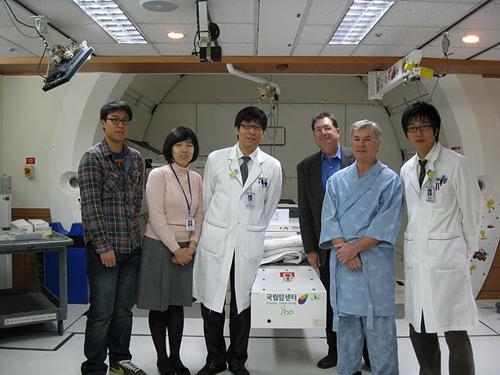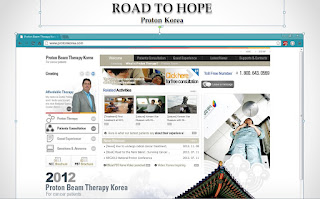Korea's medical breakthroughs drawing overseas patients
Another field of expertise where Korea is showing significant signs of improvement is in cancer research.
Curtis Poling, CEO and chief adviser to Korea's Proton Beam Radiation Therapy at the National Cancer Proton Center in Seoul, a subsidiary of the Korean Medical International Institute (KMII), was a victim himself. He was diagnosed with prostate cancer at 53.
He survived the ordeal thanks to Korea's proton therapy and for the last several years has been using his background in senior management and business development of Fortune 500 companies in creating global awareness for Korea's advanced cancer research.
"Proton therapy can use higher doses to kill cancerous cells than traditional radiation therapy (using X-ray technology), which kills many surrounding healthy cells and tissues, leading to potentially harmful and painful side effects," Poling said.
"The major advantage of proton treatment over conventional radiation is that the energy (due to the Bragg peak) distribution of protons can be directed and deposited in tissue volumes designated by the physicians, in a three-dimensional pattern from each beam used. This capability provides greater control and precision and, therefore, superior management of treatment with minimal or no side effects while killing the cancer."
Since March 2010, KMII has pioneered and created awareness in over 100 countries and 1764 cities about proton therapy in Korea. Already it has attracted a significant amount of interest from Canada, the U.K., U.S., South Africa, Argentina and the Philippines.
As of December 2010, 648 patients had been treated. Those numbers are expected to reach 900 by the end of the year.
It also helped that the Korea Tourism Organization (KTO) has been getting the word out in an aggressive online campaign -- through sponsored reports in publications such as Forbes Asia together with a platform of blogs, online cancer groups and active membership with organizations such as the National Association for Proton Therapy (NAPT).
"The real future force in patients discovering Korea will be referrals by past patients," says Jin Soo-nam, executive director of medical tourism at the KTO. "Positive experience is the real driver to growth and we are seeing that with an annual patient reunion being held this month at the NCC proton center."
Hans An van Roijen from Holland and Robert Galea from Argentina were diagnosed with prostate cancer and came to Korea for proton therapy. Both had considered alternatives but were aware of the complications.
"I considered other forms of treatment," Galea recalls, "but they all had a high risk of side effects, including impotence, urine and colon damage."
Their daily visits were no longer than half-an-hour, prep time included. Roijen and Galea returned home without any side effects.
What's on the horizon is even more promising. Early next year, Korea will introduce a new technology called IMPT (intensely modulated proton therapy) designed specifically to target more complex tumor shapes, particularly in the head, neck and abdomen that are curved - and tumors that are aggressively wrapped around the spinal cord or brain stem.
IMPT will be able to shape complex fields with a limited number of radiation angles, which ultimately keeps the treatment time as short as possible and helps spare healthy tissue.
More appealing is that all these breakthroughs will soon be more cost efficient for patients.
 |
Curtis Poling, CEO and chief adviser to Korea's Proton Beam Radiation Therapy at the National Cancer Proton Center in Seoul, a subsidiary of the Korean Medical International Institute (KMII), was a victim himself. He was diagnosed with prostate cancer at 53.
He survived the ordeal thanks to Korea's proton therapy and for the last several years has been using his background in senior management and business development of Fortune 500 companies in creating global awareness for Korea's advanced cancer research.
"Proton therapy can use higher doses to kill cancerous cells than traditional radiation therapy (using X-ray technology), which kills many surrounding healthy cells and tissues, leading to potentially harmful and painful side effects," Poling said.
"The major advantage of proton treatment over conventional radiation is that the energy (due to the Bragg peak) distribution of protons can be directed and deposited in tissue volumes designated by the physicians, in a three-dimensional pattern from each beam used. This capability provides greater control and precision and, therefore, superior management of treatment with minimal or no side effects while killing the cancer."
Since March 2010, KMII has pioneered and created awareness in over 100 countries and 1764 cities about proton therapy in Korea. Already it has attracted a significant amount of interest from Canada, the U.K., U.S., South Africa, Argentina and the Philippines.
As of December 2010, 648 patients had been treated. Those numbers are expected to reach 900 by the end of the year.
It also helped that the Korea Tourism Organization (KTO) has been getting the word out in an aggressive online campaign -- through sponsored reports in publications such as Forbes Asia together with a platform of blogs, online cancer groups and active membership with organizations such as the National Association for Proton Therapy (NAPT).
"The real future force in patients discovering Korea will be referrals by past patients," says Jin Soo-nam, executive director of medical tourism at the KTO. "Positive experience is the real driver to growth and we are seeing that with an annual patient reunion being held this month at the NCC proton center."
Hans An van Roijen from Holland and Robert Galea from Argentina were diagnosed with prostate cancer and came to Korea for proton therapy. Both had considered alternatives but were aware of the complications.
"I considered other forms of treatment," Galea recalls, "but they all had a high risk of side effects, including impotence, urine and colon damage."
Their daily visits were no longer than half-an-hour, prep time included. Roijen and Galea returned home without any side effects.
What's on the horizon is even more promising. Early next year, Korea will introduce a new technology called IMPT (intensely modulated proton therapy) designed specifically to target more complex tumor shapes, particularly in the head, neck and abdomen that are curved - and tumors that are aggressively wrapped around the spinal cord or brain stem.
IMPT will be able to shape complex fields with a limited number of radiation angles, which ultimately keeps the treatment time as short as possible and helps spare healthy tissue.
More appealing is that all these breakthroughs will soon be more cost efficient for patients.


Comments
Post a Comment